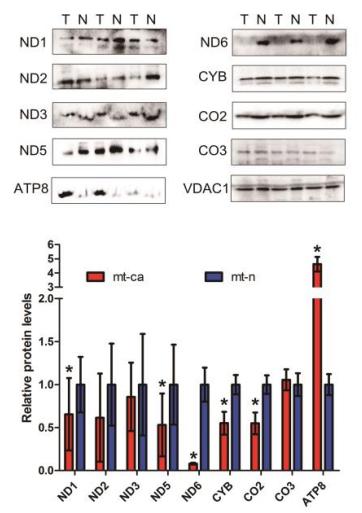MT-ND6 Antibody - #DF9676
| Product: | MT-ND6 Antibody |
| Catalog: | DF9676 |
| Description: | Rabbit polyclonal antibody to MT-ND6 |
| Application: | WB IHC IF/ICC |
| Cited expt.: | WB |
| Reactivity: | Human, Mouse, Rat |
| Mol.Wt.: | 19 kDa; 19kD(Calculated). |
| Uniprot: | P03923 |
| RRID: | AB_2842872 |
Product Info
*The optimal dilutions should be determined by the end user. For optimal experimental results, antibody reuse is not recommended.
*Tips:
WB: For western blot detection of denatured protein samples. IHC: For immunohistochemical detection of paraffin sections (IHC-p) or frozen sections (IHC-f) of tissue samples. IF/ICC: For immunofluorescence detection of cell samples. ELISA(peptide): For ELISA detection of antigenic peptide.
Cite Format: Affinity Biosciences Cat# DF9676, RRID:AB_2842872.
Fold/Unfold
Mitochondrially encoded NADH dehydrogenase 6; MT ND6; mtND6; NADH dehydrogenase subunit 6 (complex I); NADH ubiquinone oxidoreductase chain 6; NADH Ubiquinone Oxidoreductase subunit ND6; NADH6; ND6;
Immunogens
A synthesized peptide derived from human MT-ND6, corresponding to a region within the internal amino acids.
- P03923 NU6M_HUMAN:
- Protein BLAST With
- NCBI/
- ExPASy/
- Uniprot
MMYALFLLSVGLVMGFVGFSSKPSPIYGGLVLIVSGVVGCVIILNFGGGYMGLMVFLIYLGGMMVVFGYTTAMAIEEYPEAWGSGVEVLVSVLVGLAMEVGLVLWVKEYDGVVVVVNFNSVGSWMIYEGEGSGLIREDPIGAGALYDYGRWLVVVTGWTLFVGVYIVIEIARGN
Research Backgrounds
Core subunit of the mitochondrial membrane respiratory chain NADH dehydrogenase (Complex I) that is believed to belong to the minimal assembly required for catalysis. Complex I functions in the transfer of electrons from NADH to the respiratory chain. The immediate electron acceptor for the enzyme is believed to be ubiquinone (By similarity).
Mitochondrion membrane>Multi-pass membrane protein.
Belongs to the complex I subunit 6 family.
Research Fields
· Human Diseases > Neurodegenerative diseases > Parkinson's disease.
· Metabolism > Energy metabolism > Oxidative phosphorylation.
· Metabolism > Global and overview maps > Metabolic pathways.
· Organismal Systems > Nervous system > Retrograde endocannabinoid signaling. (View pathway)
References
Application: WB Species: mouse Sample: HCC and adjacent normal tissues
Restrictive clause
Affinity Biosciences tests all products strictly. Citations are provided as a resource for additional applications that have not been validated by Affinity Biosciences. Please choose the appropriate format for each application and consult Materials and Methods sections for additional details about the use of any product in these publications.
For Research Use Only.
Not for use in diagnostic or therapeutic procedures. Not for resale. Not for distribution without written consent. Affinity Biosciences will not be held responsible for patent infringement or other violations that may occur with the use of our products. Affinity Biosciences, Affinity Biosciences Logo and all other trademarks are the property of Affinity Biosciences LTD.


